Research
Research contents
Based on experimental research such as material synthesis, evaluation of physical properties, and structural analysis, we are working for creating new materials and for unveiling the origin of physical properties in ferroelectric oxides as the main target material. Ferroelectrics are polar materials with spontaneous polarization (Ps) that can be reversed by an external electric field, and exhibit various properties stemming from their unique structure. We are promoting the following research projects on polar materials including ferroelectrics.

1. Energy conversion by ferroelectric photovoltaic effect (ferroelectric solar cell)

Related papers
- Yuji Noguchi, Yuki Taniguchi, Ryotaro Inoue & Masaru Miyayama, “Successive redox-mediated visible-light ferrophotovoltaics”
Nature Communications 11, 966 (2020).
https://doi.org/10.1038/s41467-020-14763-6 - Hiroki Matsuo, Yuji Noguchi, Masaru Miyayama, Takanori Kiguchi, and Toyohiko J. Konno, “Enhanced photovoltaic effect in ferroelectric solid solution thin films with nanodomain”
Applied Physics Letters 116, 132901 (2020).
https://doi.org/10.1063/1.5142880 - Hiroki Matsuo, Yuji Noguchi, Masaru Miyayama, “Gap-state engineering of visible-light-active ferroelectrics for photovoltaic applications”
Nature Communications, 8, 207 (2017).
https://doi.org/10.1038/s41467-017-00245-9
2. Creation of new polar materials

Related papers
- Yuuki Kitanaka, Masaru Miyayama, and Yuji Noguchi, “Ferrielectric-mediated morphotropic phase boundaries in Bi-based polar perovskites”
Scientific Reports, 9, 4087 (2019).
https://doi.org/10.1038/s41598-019-40724-1 - Yuuki Kitanaka, Kiyotaka Hirano, Motohiro Ogino, Yuji Noguchi, Masaru Miyayama, Yutaka Kagawa, Chikako Moriyoshi, and Yoshihiro Kuroiwa, “Polarization twist in perovskite ferrielectrics”
Scientific Reports, 6, 32216 (2016).
https://doi.org/10.1038/srep32216
3. Development of next-generation ferroelectric thin film capacitors
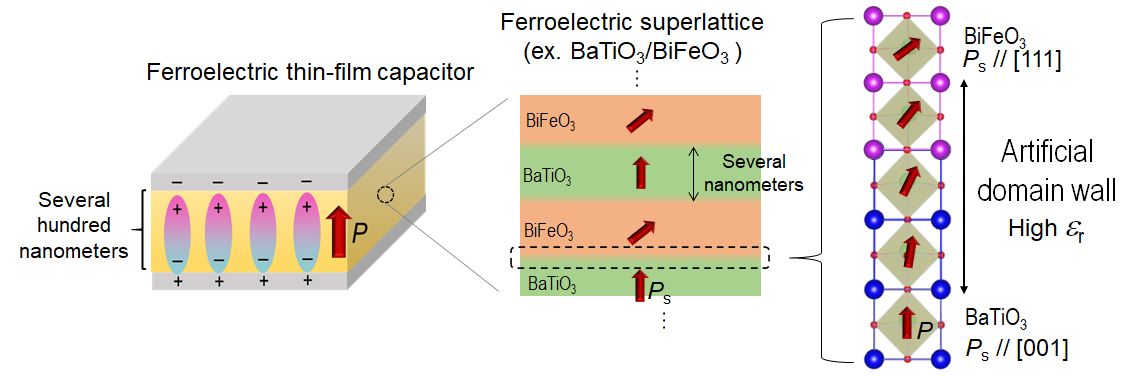
Related papers
- Yuji Noguchi, Hiroki Matsuo, Yuuki Kitanaka & Masaru Miyayama, “Ferroelectrics with a controlled oxygen-vacancy distribution by design”
Scientific Reports, 9, 4225 (2019),
The top 100 downloaded physics papers for Scientific Reports in 2019.
DOI: https://doi.org/10.1038/s41598-019-40717-0 - Yuji Noguchi, Hisashi Maki, Hiroki Matsuo, Yuuki Kitanaka, and Masaru Miyayama, “Control of misfit strain in ferroelectric BaTiO3 thin-film capacitors with SrRuO3 electrodes on (Ba, Sr)TiO3-buffered SrTiO3 substrates”
Applied Physics Letters, 113, 012903 (2018).
https://doi.org/10.1063/1.5031156 - Hiroki Matsuo, Yuuki Kitanaka, Ryotaro Inoue, Yuji Noguchi, and Masaru Miyayama, “Cooperative effect of oxygen-vacancy-rich layer and ferroelectric polarization on photovoltaic properties in BiFeO3 thin film capacitors”
Applied Physics Letters, 108, 032901 (2016).
https://doi.org/10.1063/1.4940374
4. Development of solid-state cooling device using polarized structure
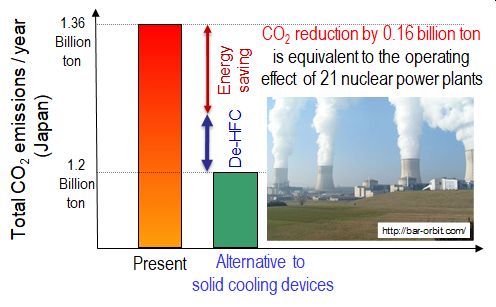
Figure Total amount of CO2 reduced by replacing the conventional heat pump type gas cooling equipment with solid cooling and the effect converted to the operation of the nuclear power plant.
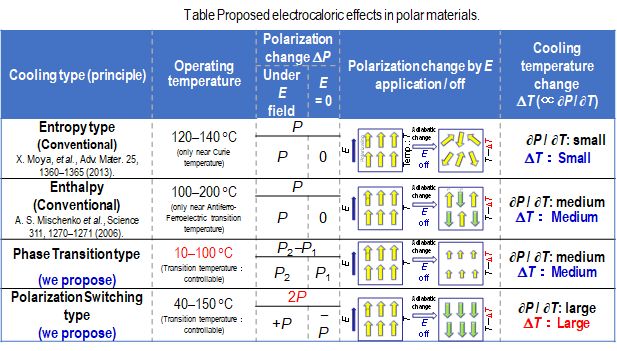
Related papers
- Yuji Noguchi, “Defect chemistry in perovskite ferroelectrics —History, present status, and future prospects— (SPECIAL ARTICLE)”
Journal of the Ceramic Society of Japan, 129 [6], 271-285 (2021).
http://doi.org/10.2109/jcersj2.21039 - Yuki ICHIKAWA, Yuuki KITANAKA, Takeshi OGUCHI, Yuji NOGUCHI and Masaru MIYAYAMA, “Polarization degradation and oxygen-vacancy rearrangement in Mn-doped BaTiO3 ferroelectrics ceramics”
Journal of the Ceramic Society of Japan, 122[6], 373-380 (2014).
https://www.jstage.jst.go.jp/article/jcersj2/122/1426/122_JCSJ-P13226/_article
5. Creation of electric field-induced phase transition materials and development of new functions
We have developed a high-quality single crystal of bismuth-based oxide, which is one of a polar material, and succeeded in controlling the ferroelectric phase (space group P4bm) and ferroelectric phase (space group P4mm) by an electric field. In addition, it is revealed that the ferrielectric phase exhibits a piezoelectric strain constant (d33> 1,000 pm/V) far exceeding the currently used lead-based ceramics; our material is a promising candidate for lead-free piezoelectric materials. In addition, by combining with first-principles calculations and thermodynamic phenomenological calculations, we have elucidated the mechanism of the electric field-induced phase transition in which the crystal structure can be controlled by an electric field.
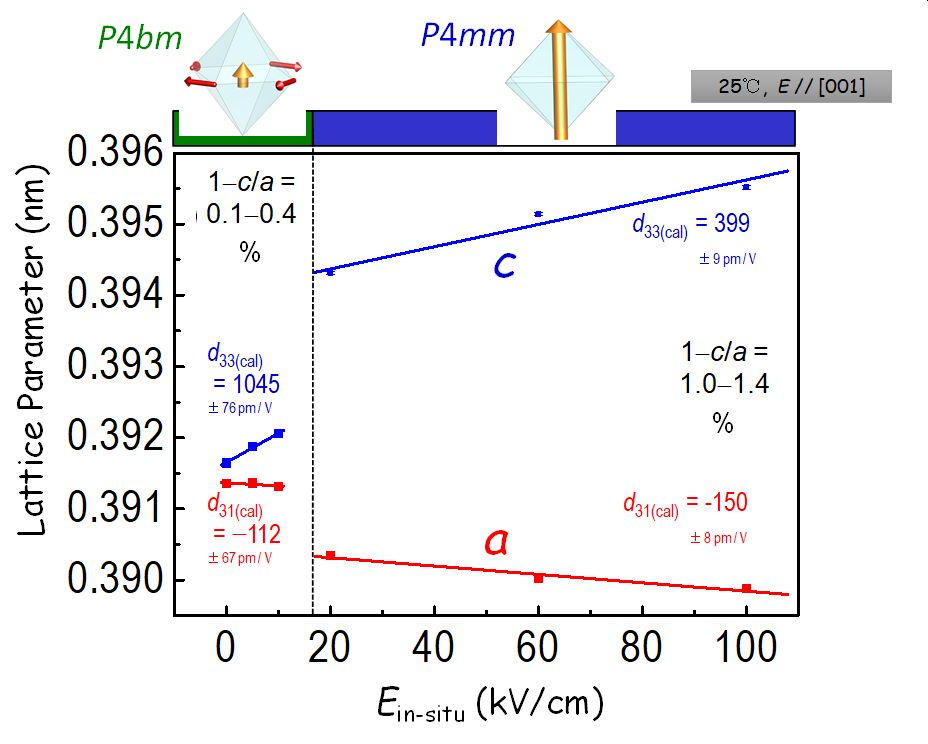
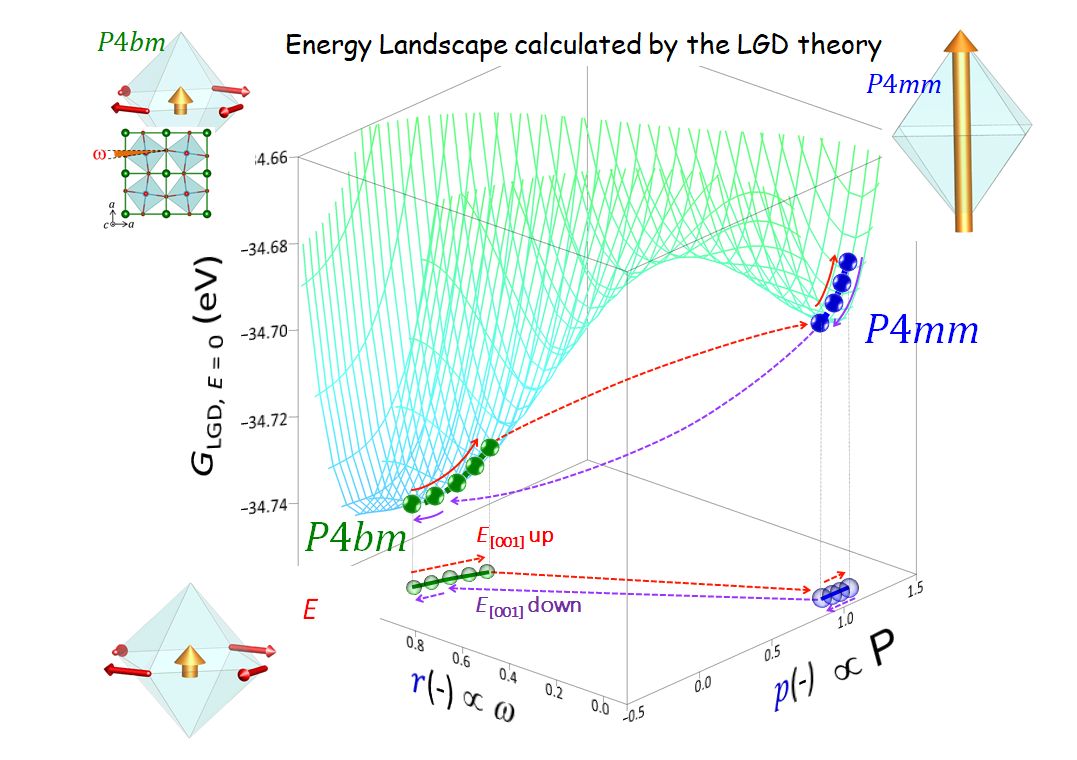
Related papers
- Yuuki Kitanaka, Kohei Makisumi, Yuji Noguchi, Masaru Miyayama, Akinori Hoshikawa, and Toru Ishigaki, “Composition-driven structural variation in ferrielectric phase of (Bi1/2Na1/2)TiO3–Ba(Mg1/3Nb2/3)O3”
Japanese Journal of Applied Physics, 58, SLLA04 (2019).
https://doi.org/10.7567/1347-4065/ab37c4 - Yuuki Kitanaka, Masaru Miyayama, and Yuji Noguchi, “Ferrielectric-mediated morphotropic phase boundaries in Bi-based polar perovskites”
Scientific Reports, 9, 4087 (2019).
https://doi.org/10.1038/s41598-019-40724-1 - Yuuki Kitanaka, Takuya Egawa, Yuji Noguchi, and Masaru Miyayama, “Enhanced Polarization Properties of Ferrielectric AgNbO3 Single Crystals Grown by Czochralski Method under High-Pressure Oxygen Atmosphere”
Japanese Journal of Applied Physics, 55, 10TB03 (2016).
http://doi.org/10.7567/JJAP.55.10TB03
6. Elucidation of the electronic mechanism of polar-driven functions
So far, in Bi-based ferroelectrics, the rhombic crystal (space group R3c) is stabilized in the Bi-Na system, and the tetragonal crystal (space group P4mm) is stabilized in the Bi-K system, but the mechanism is unknown. Through experiments for high-quality single crystals and first-principles calculations, we found that the orbital hybridization of Bi-6p and O-2p electrons play an important role in the stability of the systems.
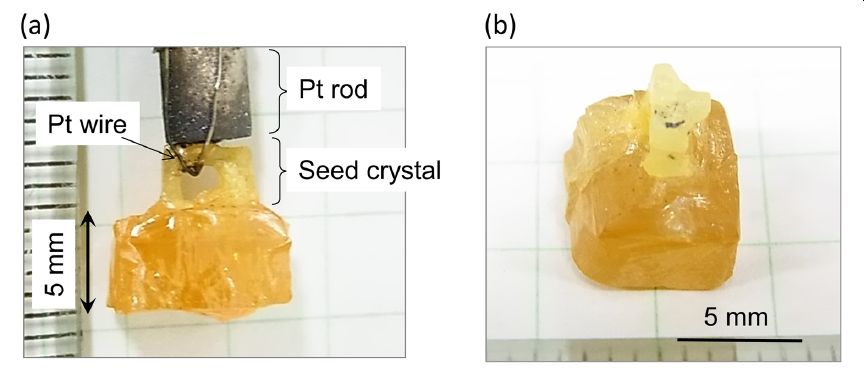
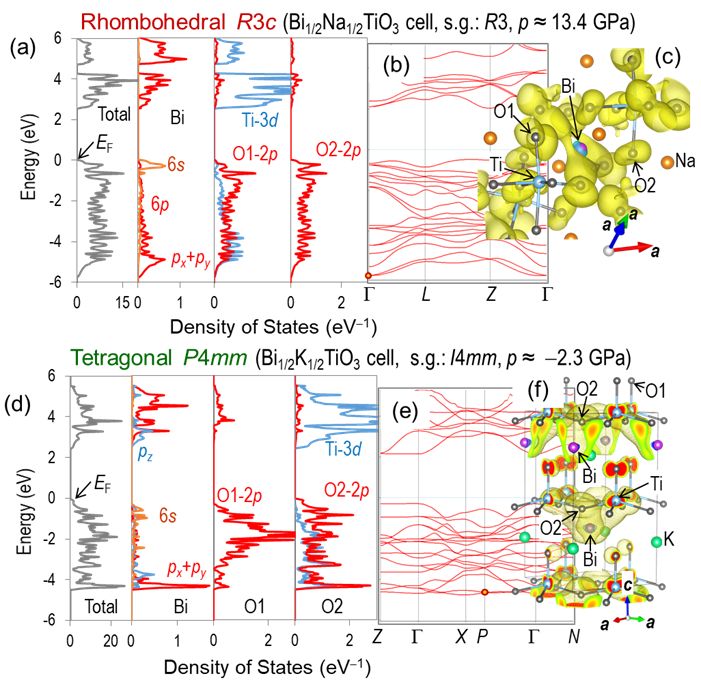
Related papers
- Yuuki Kitanaka, Yuji Noguchi, and Masaru Miyayama, “Uncovering ferroelectric polarization in tetragonal (Bi1/2K1/2)TiO3–(Bi1/2Na1/2)TiO3 single crystals”
Scientific Reports 9, 19275 (2019).
doi:10.1038/s41598-019-55576-y - Tomohiro Abe, Sangwook Kim, Chikako Moriyoshi, Yuuki Kitanaka, Yuji Noguchi, Hiroshi Tanaka and Yoshihiro Kuroiwa, “Visualization of spontaneous electronic polarization in Pb ion of ferroelectric PbTiO3 by synchrotron-radiation X-ray diffract Visualization of spontaneous electronic polarization in Pb ion of ferroelectric PbTiO3 by synchrotron-radiation X-ray diffraction ion”
Applied Physics Letters, 117, 252905 (2020).
https://doi.org/10.1063/5.0037396 - Yuji Noguchi, “Defect chemistry in perovskite ferroelectrics —History, present status, and future prospects— (SPECIAL ARTICLE)”
Journal of the Ceramic Society of Japan, 129 [6], 271-285 (2021).
http://doi.org/10.2109/jcersj2.21039
Research Facilities
1. Pulsed laser deposition (PLD)
This is a facility in which a target material installed in the vacuum chamber is turned into plasma by a pulsed laser and a thin film is deposited on the opposite substrate. This is used to fabricate epitaxial films of dielectrics and ferroelectrics.
2. TSSG(Top-Seeded Solution Growth)furnace
This is a furnace that enables us to grow single crystals by using a seed crystal. In particular, it is possible to grow single crystals under high oxygen pressure of nine atm, and high-quality ferroelectric single crystals with low defect concentration can be obtained.
3. Multipurpose X-ray diffractometer
This is an XRD facility for analyzing crystal structures and domain structures of epitaxial thin films. In addition to high-resolution reciprocal lattice mapping using a high-speed one-dimensional detector, wide-area reciprocal lattice mapping and pole-figure measurements using a two-dimensional detector are available.
4. X-ray fluorescence analyzer
This is a facility to quantify the composition of samples in ceramic, single-crystal and film forms.
5. Desktop X-ray diffractometer
XRD diffractometer for powder samples.
6. Muffle furnace
Electric furnaces for sample preparation.
7. Quench furnace
An annealing/quenching furnace in which oxygen partial pressure can be controlled.
8. Ferroelectric measurement system
This system enables us to evaluate polarization, piezoelectric and leakage-current characteristics.
9. Photovoltaic effect measurement system
This system enables us to evaluate photovoltaic characteristics under light with a controlled wavelength.
10. Low/high temperature prober
A prober for measuring electrical properties of samples using microelectrodes.
11. Ultraviolet-visible spectrophotometer
A spectrophotometer capable of measuring transmission / reflection spectrum in the ultraviolet / visible light region. Powder diffuse reflection spectrum measurements are also available.
12. Glove box
Experiments in an inert atmosphere and low dew point environment are possible. It is used for strict weighing of hygroscopic reagents.
13. Atomic force microscope, piezoresponse force microscope
It is a probe microscope that can observe a surface morphology at the atomic scale. Domain structures of ferroelectrics can also be observed by a contact resonance piezoresponse method.